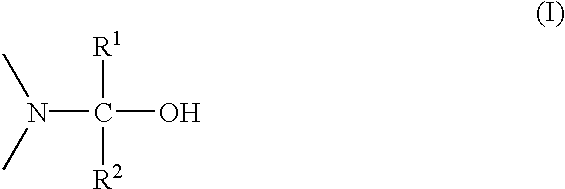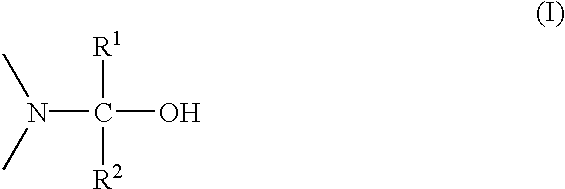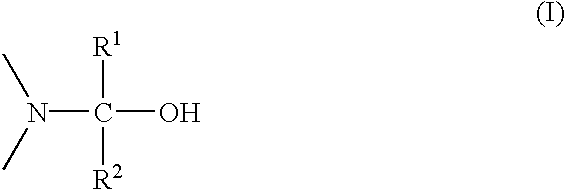Resist stripping agent and process of producing semiconductor devices using the same
a technology of resist stripping agent and semiconductor device, which is applied in the direction of photomechanical treatment, instruments, electrical equipment, etc., can solve the problems of less effective organic amine-containing stripping agent for removing resist films and resist residues, and less effective organic amine-containing stripping agent for removing sidewall polymers,
- Summary
- Abstract
- Description
- Claims
- Application Information
AI Technical Summary
Benefits of technology
Problems solved by technology
Method used
Image
Examples
example 45
The semiconductor devices used in Examples 17-31 were immersed in a stripping agent at 50.degree. C. for 3 minutes, rinsed with isopropanol, dried and observed under SEM. The stripping agent comprised 25% by weight of N-hydroxymethylethanolamine, 35% by weight of ethanolamine, 15% by weight diethylene glycol monobutyl ether, 7% by weight of sorbitol, 0.5% by weight of TMAH and 17.5% by weight of water. As a result of SEM observation, it was confirmed that the resist residue 5 of any of the semiconductor devices was completely removed with no corrosion on the aluminum (Al--Cu) circuit pattern.
As described above, the resist stripping agent of the present invention has excellent removal capability, and easily removes resist films and resist residues at lower temperatures for a short period of time. In addition, during the removal of resist, the resist stripping agent causes no corrosion against inorganic substrates made of various materials. With these properties, the resist stripping ...
PUM
| Property | Measurement | Unit |
|---|---|---|
| molar ratio | aaaaa | aaaaa |
| temperature | aaaaa | aaaaa |
| temperature | aaaaa | aaaaa |
Abstract
Description
Claims
Application Information
 Login to View More
Login to View More - R&D
- Intellectual Property
- Life Sciences
- Materials
- Tech Scout
- Unparalleled Data Quality
- Higher Quality Content
- 60% Fewer Hallucinations
Browse by: Latest US Patents, China's latest patents, Technical Efficacy Thesaurus, Application Domain, Technology Topic, Popular Technical Reports.
© 2025 PatSnap. All rights reserved.Legal|Privacy policy|Modern Slavery Act Transparency Statement|Sitemap|About US| Contact US: help@patsnap.com



